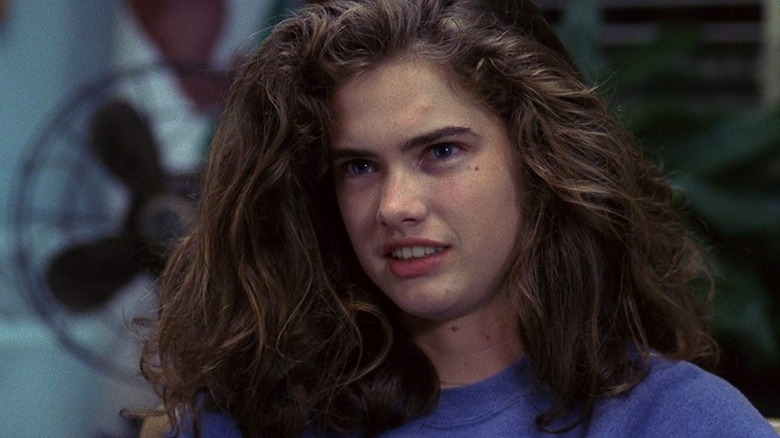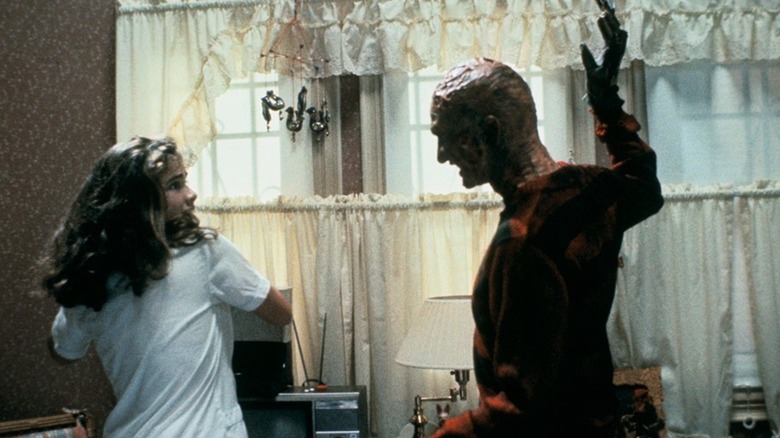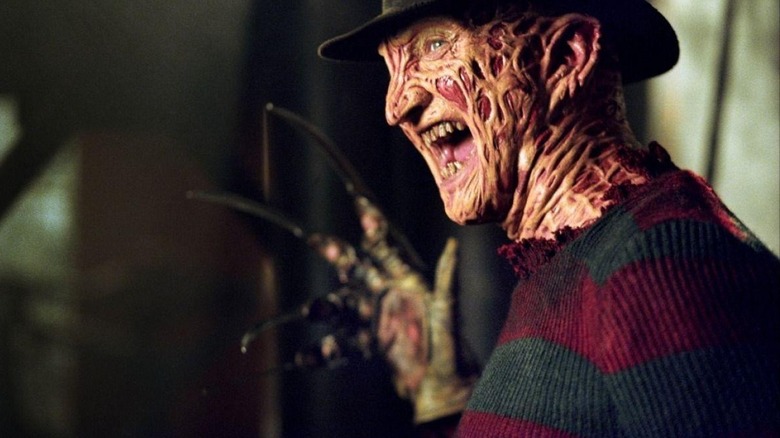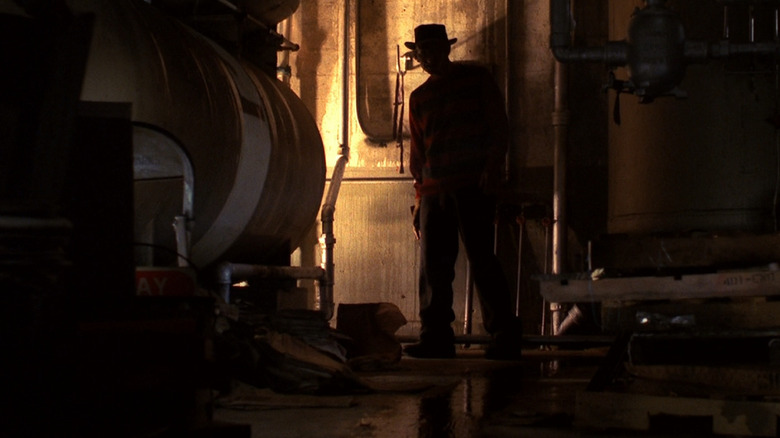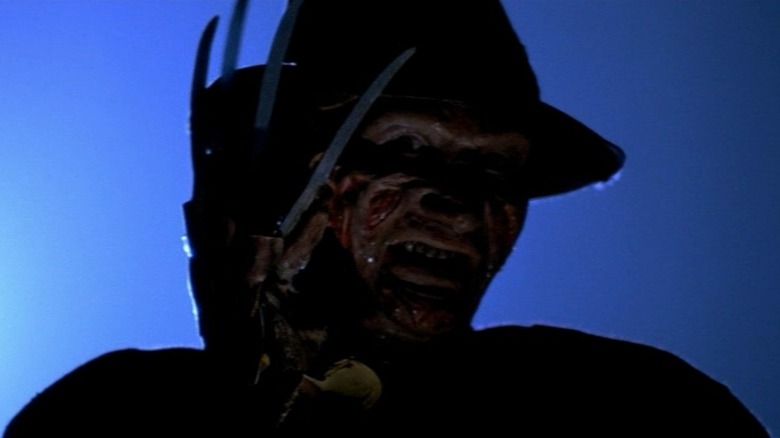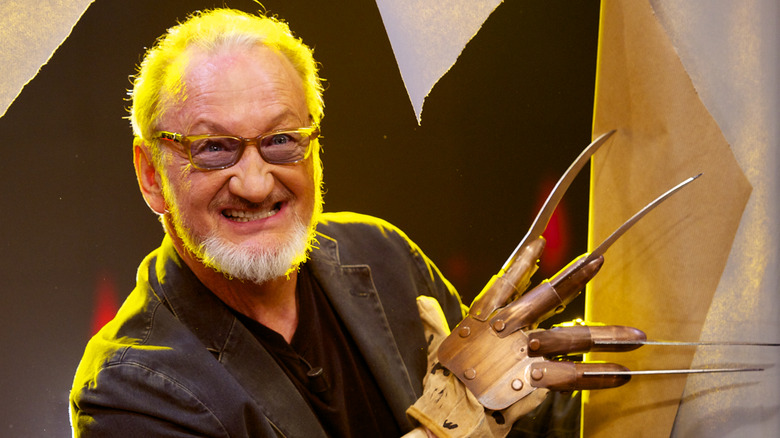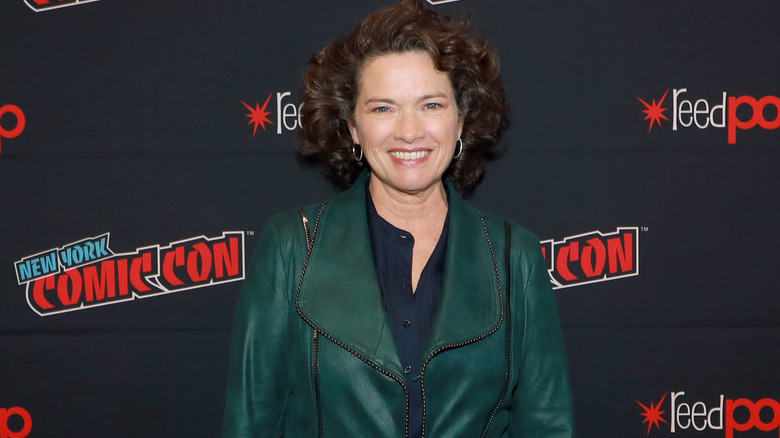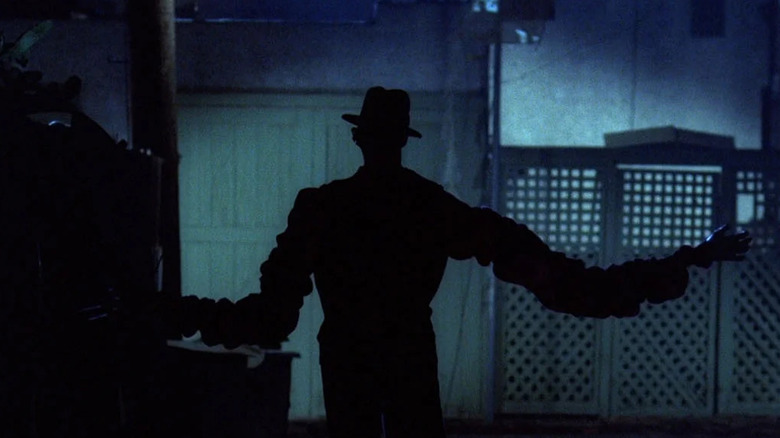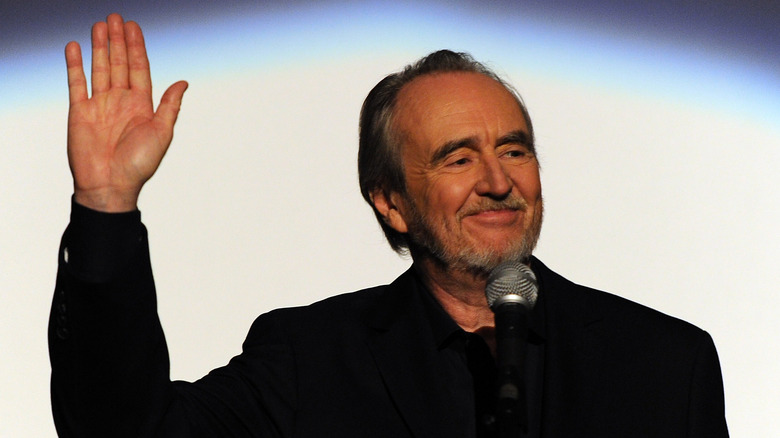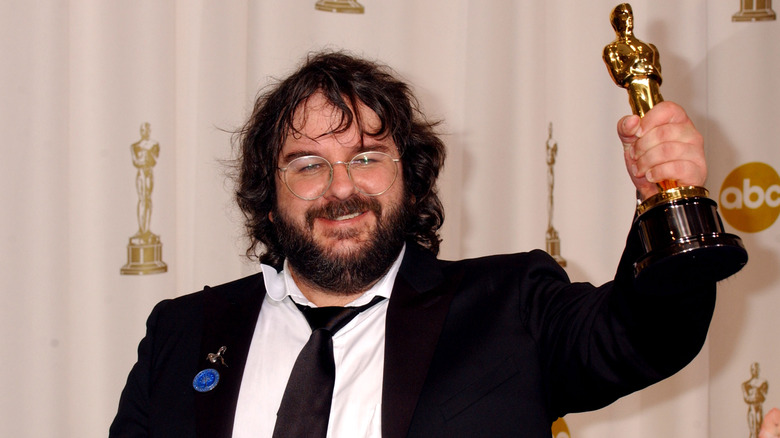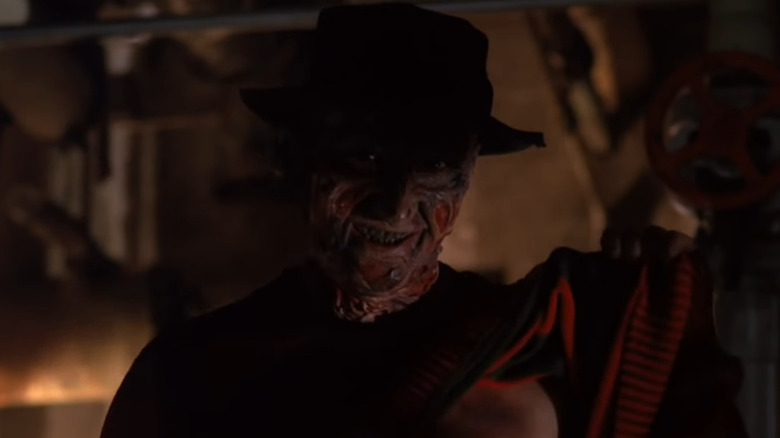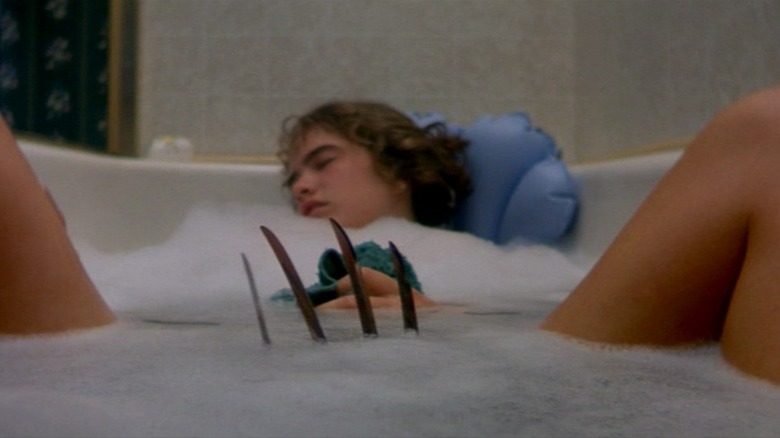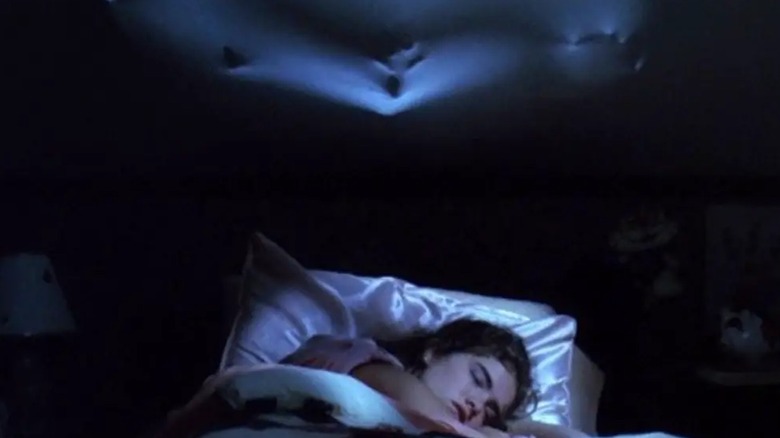The Untold Truth Of A Nightmare On Elm Street
Few films can ever hope to achieve the level of cultural impact of 1984's "A Nightmare on Elm Street," and few characters are as beloved and instantly recognizable as the one and only Freddy Krueger. It's a simple premise: A child killer returns from beyond the grave to torment and murder the teenage children of the parents who burned him alive many years earlier. With unexplainable supernatural abilities, Krueger is able to enter their dreams and shape the fabric of the dream reality to his whim. And of course, if you die in the dream, you die in real life.
In addition to helping launch several careers, including that of a young Johnny Depp, the film also helped permanently establish director Wes Craven as one of the undisputed masters of the horror genre. After making a name for himself as a director of low-budget horror that routinely wound up on the video nasty list and banned in certain countries, Craven soared to new heights and far greater mainstream success with "A Nightmare on Elm Street." The flick's massive success led to five direct sequels, a meta-reboot in the form of "Wes Craven's New Nightmare," an anthology television show, a crossover spinoff with Jason Voorhees of the "Friday the 13th" franchise, and a 2010 remake that was swiftly forgotten about in favor or prioritizing the original.
The film turned a struggling studio into an industry juggernaut
In the modern age, New Line Cinema is a subdivision of Warner Bros. that continues to distribute and co-produce feature films and television shows. Before falling on hard times and merging with WB in 2008, New Line Cinema was an independent label that once enjoyed meteoric success. The height of their powers arrived at the turn of the century with the "Lord of the Rings" trilogy, but they never would have been in the position to produce those costly films without the property that gave them their first taste of major success: "A Nightmare on Elm Street."
From its origin in the late 1960s, New Line Cinema had always been struggling to find its footing and its identity. Wes Craven was shopping his script for "A Nightmare on Elm Street" around and also struggling to gain any traction. In the documentary "Welcome to Prime Time," Craven said, "Absolutely nobody thought it was scary. Nobody thought it was good, except for Bob Shaye." Shaye was the head of New Line Cinema at the time, and meeting turned out to be extremely beneficial for both of them. The film was a hit, spawned a line of successful sequels, and essentially saved the struggling studio.
The surprisingly scientific reason why Freddy's sweater is so iconic
Freddy Krueger's iconic sweater likely brings Christmas to mind with its red and green color scheme, a stark contrast to the typical horror conventions. The reasoning behind this wardrobe choice had nothing to do with the holiday and was instead informed by cold hard science and a desire to make Freddy stand out from the other slasher villains that were filling up the cinemas at the time. As Craven explained in the making-of documentary, "I wanted him to have something instantly recognizable ... gave him a sweater with stripes and made them that sort of shade of green and red that I had found in a book of colors that grate; that are hard on the eye. It's one of the hardest combinations of colors for the eye to process."
Scientific American labels red and green as "opponent colors," which means that the average human eye cannot process them both at once when they are present side-by-side. By making Freddy's wardrobe slightly scientifically troubling to the eye, Craven was able to make his villain just that little bit extra unsettling upon first glance on a subconscious level.
Robert Englund had to fight to wear the fedora
There is no Freddy Krueger without Robert Englund, a point that the critical thrashing of the 2010 remake was sure to make clear. Englund had already been acting for an entire decade by the time "A Nightmare on Elm Street" came around, but he was by no means a big star with the sway to easily influence the production. One element of the movie that he had to fight for was Freddy's trademark hat, a battered, dark brown fedora.
Wes Craven had the original idea for the hat right from the get-go, but the folks at New Line Cinema had reservations about going with the fedora. Englund described the situation in an interview with Yahoo! "They had this box of hats ... and I'm sitting there in the makeup going 'guys, please, the fedora's right,'" he recalled, "and they kept putting on like paperboy hats and baseball hats, and, God, one hat looked like a pimp hat. It was like, what are you thinking, you guys?" Englund was eventually able to get through to them by donning the fedora and pointing out how striking it made his shadow and silhouette look.
Wes Craven looked back to the dawn of humanity when choosing Freddy's weapon
"A Nightmare on Elm Street" hit theaters in 1984, quite a few years after the start of the gold rush of slasher movies that followed in the wake of 1978's "Halloween." With so many disposable slasher flicks coming and going in the intervening years, Wes Craven knew he needed to give his slasher villain a distinctive and memorable weapon to help him and the film stand out. Plenty of slasher movies had played around with all manner of weapons of both the practical and novelty varieties, but none had ever utilized the beautiful and chilling simplicity of a leather glove with four blades extending from the fingers.
Craven arrived at the idea for the blade glove by challenging himself to think of the most primordial human fear. What was it that the earliest humans feared the most? Fire? The spear? No. The claws of predator animals. Craven described his thought process in that behind-the-scenes documentary, saying, "Let's take a combination of the human hand, which is the epitome of mankind ... and combine that with the claw that I'm sure the most primeval man was cowering from." The heady approach that Craven took when making every decision from Freddy's wardrobe to his signature weapon served to elevate the horror stylings significantly and turn the character into the horror icon that he was destined to become.
Robert Englund disagrees with a common belief about Freddy Krueger
In the pop culture zeitgeist, many viewers believe Freddy Krueger to have been a child molester as well as a child murderer, but Englund says that this isn't true. As far as Englund sees it, Freddy is a child killer but not a child molester, and he pointed to that distinction as one of the reasons the 2010 remake failed. Englund told Variety, "By taking it to such a dark, dark place, there's no room for the personality of Freddy to be exploited."
While Freddy is explicitly a child molester in the remake, the original film never made that clear. The details of Freddy's pre-supernatural backstory are kept rather vague in the first movie, and the character's background wasn't always particularly consistent across the sequels. It's possible to read between the lines and walk away with the conclusion that Freddy was a child molester, but it isn't included within the text of the film. The widespread belief that Freddy sexually abused the children he killed is actually a bit of a Mandela effect that Englund says has never been a part of how he approached the role.
If you or someone you know may be the victim of child abuse, please contact the Childhelp National Child Abuse Hotline at 1-800-4-A-Child (1-800-422-4453) or contact their live chat services.
The cast reunited in 2020 to update the nursery rhyme
There are not many horror villains who have their own nursery rhyme, but then again, Freddy Krueger was never one to abide by the established mores of the slasher genre. The nursery rhyme can be heard multiple times throughout the series, having first appeared in the original movie sung by a group of young girls in white playing jump rope. As a play on the existing "One, Two, Buckle My Shoe" nursery rhyme, Freddy's version goes simply: "One, two, Freddy's coming for you/Three, four, better lock your door/Five, six, grab your crucifix/Nine, ten, never sleep again." The last line is not just pertinent advice for combating Freddy but also provided the name of the gargantuan four-hour retrospective documentary "Never Sleep Again: The Elm Street Legacy."
In 2020, a bunch of original cast members reunited to update the nursery rhyme. The lyrics were altered to turn the rhyme into a PSA about the COVID-19 pandemic rather than a PSA about the dangers of Freddy Krueger. The video was titled "Stop the Nightmare" and featured rhymes about self-isolating and washing your hands. Robert Englund was the one big cast member who was notably absent from the video, but he had already made his own COVID video earlier on, which involved him using the trademark Freddy Krueger glove and doing the character's iconic laugh.
Freddy Krueger almost looked completely different
Out of all the numerous slasher films throughout horror history, Freddy Kreuger undoubtedly has one of the most distinctive appearances. From the colorful wardrobe and unique weapon to his badly burned skin, there's no mistaking Freddy. However, the character nearly looked drastically different in the first film.
Both the iconic wardrobe and the burn makeup went through various permutations throughout the preproduction phase of "A Nightmare on Elm Street." In addition to the alternate hats that the folks at New Line Cinema made Englund try out, the rest of his outfit was nearly different too. Wes Craven had the striped sweater in mind right away, but they almost went with a sleeveless sweater vest instead, which would have completely changed up the character's whole vibe. It's also worth noting that the sleeves Freddy ended up with in the first movie do not have stripes, whereas every other "A Nightmare on Elm Street" movie added stripes to the sleeves along with the torso.
The effects team tried out many different versions of Freddy's burn makeup, some more gruesome and some less gruesome than what wound up on screen. The final makeup design took four-and-a-half hours to apply to Englund each day, but it could have been even more complicated. In "Welcome to Prime Time," Englund said, "I know Bob Shaye had always wanted Freddy to look more melted." He explained that they tried a version of the makeup with dangling bits of flesh that might have looked a little more realistic, but also looked a little silly when he moved around.
Wes Craven regretted allowing A Nightmare on Elm Street to become a franchise
When Wes Craven wrote "A Nightmare on Elm Street," he intended it to be a self-contained one-and-done horror film that ended with Freddy Krueger's definitive death. He was against the idea of turning the property into a franchise, and judging from some of the directions the series went, it's hard to blame him. Some of the sequels brought a lot of good things to the table, but others displayed a steep drop-off in quality, not to mention the cheesy "Freddy's Nightmares" TV show and all of the garish, shameless product tie-ins that cheapened the once-frightening villain's allure.
It was Bob Shaye, the head of New Line Cinema, who had dollar signs in his eyes when it came to Freddy Krueger. He insisted on changing the original film's ending to leave it open for sequels and, after it proved to be box-office dynamite, he capitalized on that sequel potential as thoroughly as possible. New Line Cinema first approached Craven to make the sequel, but he couldn't be persuaded to return to the series, so new directors were brought on for each of the sequels. Craven only circled back around to Freddy Kreuger after the mainline series had died to deliver "Wes Craven's New Nightmare," which took a meta approach and completely disregarded the canon of the sequels.
Peter Jackson wrote a Nightmare on Elm Street sequel that was never made
After the "A Nightmare on Elm Street" franchise began to lose steam at the box office, New Line Cinema made the decision to pull the plug on the series, but not before giving Freddy Krueger what they hoped would be a proper send-off. With Craven still not interested in returning to the franchise, the hunt for a final script was underway. A young Peter Jackson — who at that time had only made a couple of ultra-low budget movies: "Bad Taste" and "Meet the Feebles" — was tapped to write a script for what would be the final "A Nightmare on Elm Street" film.
Jackson wrote "A Nightmare on Elm Street: The Dream Lover" with his friend Danny Mulheron, who had previously starred in "Meet the Feebles," which the two of them had also co-written alongside Fran Walsh and Stephen Sinclair. New Line Cinema ended up shelving his script in favor of producing "Freddy's Dead: The Final Nightmare" written by Michael De Luca and Rachel Talalay, who were both established figures at New Line Cinema and had already worked on other "A Nightmare on Elm Street" projects.
Those who have read "The Dream Lover" report that Jackson's script was quite good. It was sure to be a significantly better send-off than Freddy received instead. New Line Cinema still ended up working with Jackson years later when they produced his "Lord of the Rings" trilogy.
Freddy's face was modeled after a piece of cheese
Everybody knows that the design of Freddy Krueger's makeup is meant to resemble someone who was subjected to severe burns over his entire body. The specific look of his makeup design was partly inspired by real burn injuries, as you might expect, but makeup effects artist Dave Miller actually took more inspiration from an unlikely source instead: cheese.
In an interview for "Welcome to Prime Time," Miller explained that after hearing Wes Craven describe his ideal appearance for the character, he was struck with inspiration by his dinner one night during the pre-production phase. He said, "One night I was eating pizza in a pizza parlor. I was just kind of playing with the cheese with my fork—it was a pepperoni pizza, so I was kind of rearranging the cheese around the pepperoni," and that gave him the idea for how to pull off Freddy's makeup. He added, "Instead of eating it, I took it home and used that as a guideline for creating Freddy's face."
Heather Langenkamp wants to reprise her role
Before starring in "A Nightmare on Elm Street," Heather Langenkamp had only appeared in the made-for-TV movie "Passions" and briefly popped up in "The Outsiders," only for her scenes to be deleted. Her first starring role remained the largest role of her entire career, and Langenkamp became inseparable from the character of Nancy Thompson in the eyes of countless horror fanatics.
Though she lived through the first movie, Nancy didn't remain a key player throughout the sequels. She returned in "A Nightmare on Elm Street 3: Dream Warriors" but was no longer the main character, and she was killed off at the end. Her only other appearance in the franchise was outside the mainline sequels with "Wes Craven's New Nightmare," in which she actually played herself rather than Nancy, highlighting how intertwined reality and fiction can be.
Similar to how Jamie Lee Curtis returned for the modern "Halloween" trilogy that ignored previous sequels, Langenkamp wants to reprise her role as Nancy for the modern age. She mentioned the success of Curtis' reprisal specifically and told Entertainment Tonight, "If Nancy could fight Freddy one last time, I would really like that ... I would love to see a future in that ... I wish I was in control of that."
The terrifying medical anomaly that inspired Freddy's dream powers
At face value, Freddy Krueger's ability to kill people in their dreams seems like pure supernatural fiction, but his method of murder actually takes more inspiration from reality than you would probably hope. As it turns out, Wes Craven got the idea for Freddy's dream murders after reading about a series of bizarre sleep-related deaths in the newspaper.
The medical anomaly was sometimes known by the name "Asian Death Syndrome" but was most commonly referred to as "Sudden Unexplained Death Syndrome," or "SUDS" for short. The name "Sudden Unexplained Nocturnal Death Syndrome" or "SUNDS" was sometimes used as well. For reasons that never became perfectly clear, SUDS seemed to only happen to men from Southeast Asian countries, most of whom were living as refugees in the United States at their time of death.
The men seemed perfectly healthy, and no clear cause of death was ever readily apparent, but there were numerous instances of these men dying within moments of falling asleep. What made the condition even more terrifying — and a better basis for a horror film where a villain could be injected into the plot — was the fact that some of the victims seemed to know what was going to happen to them as they reportedly attempted to force themselves to stay awake for as long as possible, then died as soon as they finally fell asleep.
SUDS sounds like it would have been a freak occurrence that happened just a couple of times, but 117 deaths were attributed to the syndrome by the CDC between 1981 and 1988. SUDS remained an ongoing issue for years that defied explanation.
